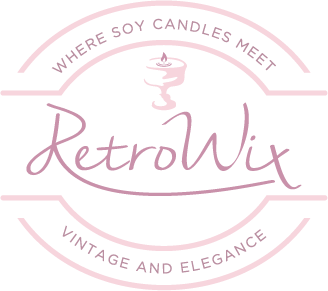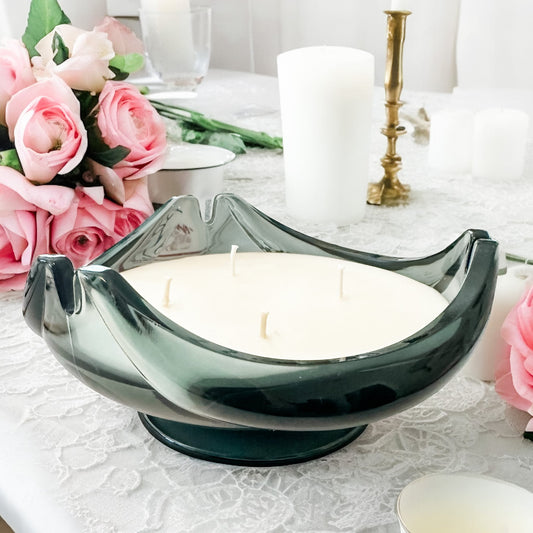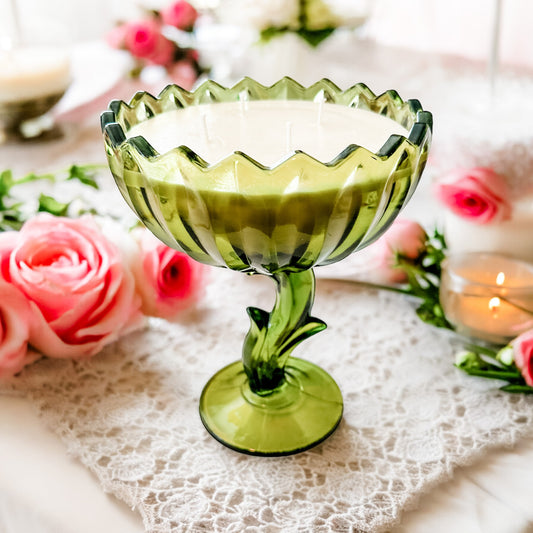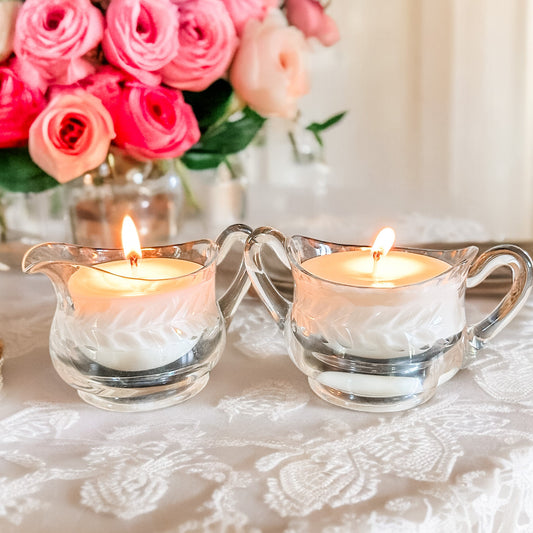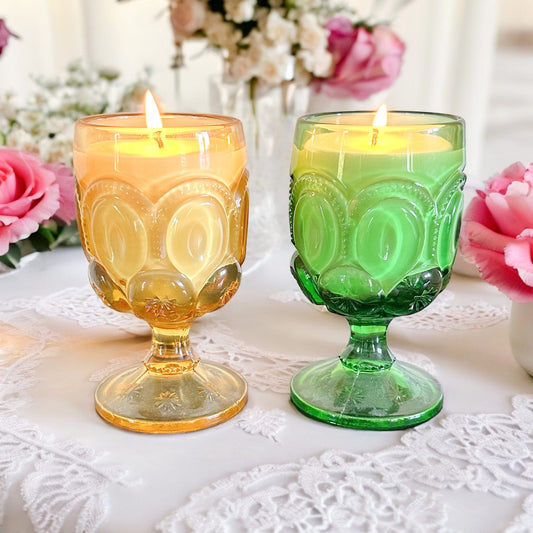FAQS
FAQS about Soy Candles
BENEFITS OF SOY WAX
- Soy wax is derived from a vegetables, (soy beans), while it's counter partner, paraffin wax is derived from petroleum (a refined a gasoline product).
- Soy wax is a natural, renewable resource.
- Soy wax is biodegradable and cleans up with plain old soap and water.
- Soy wax has a lower melting point than paraffin wax and because of this, soy candles will burn slower or longer than paraffin candles.
- Soy wax burns with zero petro soot, creating petro soot free candles. Paraffin candles burn with petro-soot.
HOW TO BURN A CANDLE SAFELY
BEFORE LIGHTING
- Trim the wick to ¼ inch each time before burning. Long or crooked wicks can cause uneven burning, dripping or flaring.
- Burn candles in a well-ventilated room.
- Keep the wax pool clear of wick trimmings, matches and debris at all times.
- Avoid drafts, vents or air currents. This will help prevent rapid or uneven burning, sooting, and excessive dripping.
WHILE BURNING
- Never touch or move a burning candle. Never move a votive or container candle when the wax is liquefied.
- Don’t burn a candle all the way down. For a margin of safety, discontinue burning a candle when 2 inches of wax remains (1/2 inch if in a container).
- Extinguish a candle if the flame becomes too high or flickers repeatedly. Let the candle cool, trim the wick, and check for unwanted drafts before re-lighting.
- Always keep the candle within your sight. If you are going to leave the room, be sure to first blow out all candles.
- Always burn candles in a well-ventilated room. Don’t burn too many candles in a small room or in a “tight” home where air exchange is limited.
- Never burn a candle on or near anything that can catch fire. Keep burning candles away from furniture, drapes, bedding, carpets, books, paper, flammable decorations, etc.
- Keep candles out of the reach of children and pets. Do not place lighted candles where they can be knocked over by children, pets or anyone else.
WHEN EXTINGUISHING
- Use a candle snuffer to extinguish a candle. It’s the safest way to prevent hot wax from splattering.
- Never use water to extinguish a candle. Water can cause the hot wax to splatter and might break a glass container.
- Make sure the candle is completely out and the wick ember is no longer glowing before leaving the room.
- Don’t touch or move the candle until it has completely cooled.
- Never use a knife or sharp object to remove wax drippings from a glass holder. It might scratch, weaken, or cause the glass to break upon subsequent use.
COMMON QUESTIONS ABOUT SOY CANDLES
What causes the white marks on my soy candles?
Occasionally, white marks may appear on soy candles due to the nature of the soy wax. The tiny, white looking crystals on the tops and sides of jars are called frosting and are very similar to the frosted look on chocolate. This is a natural characteristic of soy wax and should not be treated as a flaw. It does not affect the quality or burn of the candle.
Why is there is wet oil on top of my soy container candle?
Since soybean wax has a lower melting point than paraffin wax, it can release excess (fragrance) oils which it cannot hold (usually due to extreme temperature changes due to shipping - i.e. going from hot trucks to an air-conditioned environment or going from cold trucks in the winter to heated stores). You can leave it or wipe it out with a tissue or paper towel. Sweat from soy candles does not affect the burn quality and generally the sweat drops will not show up again after your first burn.
For optimum performance of soy candles, please store in a cool area out of in-direct and direct sunlight. Also, it can be caused by the scent sweating or separating out of the soy candles. We have found that 100% soy wax does not mix well with high concentrations of pure essential oil. Therefore, scented soy candle jars are more likely to sweat when warmed during shipping. This is just the fragrance oils coming to the surface. Some soy candle manufacturers recommended that you blot the top with a Kleenex or paper towel to prevent spillage.
Why does my soy candle look frosty? Is it drying out?
No, your soy candle does not dry out. Frosting is a natural characteristic of soy. It is not a flaw. It is strictly unique to pure soy candles. Often times it is called the "bloom". Actually, many customers are concerned if there is no frosting on their soy candles. It is a way that a customer can tell if their candle is really made with pure, all-natural soy wax. It's part of the soy experience!
Frosting does not seem to affect the scent throw or the burning properties of the candle. You can safely burn a candle with a bloom without worry. Frosting is a particular crystal growth of vegetable oils. It will cause the candle to look dry, which is simply a characteristic of that crystal structure, but has nothing to do with the candle "drying out". To minimize frosting, try to keep your candle out of direct sunlight and florescent lighting. Even changes in the weather can cause additional frosting. It is almost impossible to stop the soy wax from blooming.
Information taken from:http://www.alohabay.com/people/soy-beeswax-candles-frequently-asked-questions.html#7
The selection process for RetroWix containers is fun but also very thorough. We only select vintage pieces in excellent condition with very little wear. We have a list of characteristics that we look for in each dish regarding overall condition, glass thickness, type, size, and the shape of the container before we turn into a beautiful vintage candle. Once in our studio, we have another checklist to ensure we provide you the best and safest candle possible. These steps and following our recommended safety guidelines below will allow you to enjoy your vintage piece for many years to come.
What are the manufacturer recommendations for burning your candles?
We recommend that you follow all of the candle safety guidelines above which is also provided with your purchase. As these are vintage dishes, we find it especially important to trim your wick 1/4" before each burn. This helps the candle burn evenly and stay cooler. Also, only burn the candle for 4 hours at a time and discontinue use when you reach 1/4" of wax on the bottom of container. Leaving 1/4" of wax protects your vintage piece by preventing it from becoming too hot.
How do I remove wax once I'm finished burning?
Soy wax washes off RetroWix containers with good ole soap and warm water. Remove excess wax carefully and throw away. It will break apart easily. Once you have removed the wax, you can wash container with warm water and soap. If the wick is still adhered, use hot tap water to help loosen the glue that is adhered to the bottom of wick. Carefully remove using an object to gently lift the metal bottom of the wick.
IMPORTANT:
Never use a knife or sharp object to remove wax drippings from a glass holder. It might scratch, weaken, or cause the glass to break upon subsequent use. (Trust me...I've done this) My preferred tool to remove wax is a chopstick. This is safe and minimizes scratches.
If your wick is still giving you problems, repeat the process above. Please make sure you are careful not to get soy wax in your plumbing. It will still harden and can cause problems.
Check out our New Arrivals...
-
Spiced Honey & Tonka Candle in Vintage Glass Ashtray
Regular price $64.95 USDRegular priceUnit price / per -
Gardenia Tuberose Candle in Vintage Glass Compote | RetroWix
Regular price $84.95 USDRegular priceUnit price / per -
Tulip Garden Scented Candle | Vintage Cambridge Glass Set
Regular price $64.95 USDRegular priceUnit price / per -
Vintage Gardenia Tuberose Candle | Moon & Star Glass Goblet
Regular price $49.95 USDRegular priceUnit price / per
